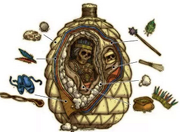| Cotton King Mummy Human Mummy | |
| Biographical Information | |
|---|---|
| Name(s) | unknown, member of the "Cotton King" bundle |
| Age | adult |
| Sex | male |
| Status | nobleman |
| Height | |
| Source | |
| Culture | Inca upper class |
| Date(s) | buried between 1480-1535 |
| Site | Rimac Valley outside Lima, Peru |
| Current Location | |
| Location | Puruchuco |
| Catalog # | |
Discovered by archaeologists in 1999, the so-called Cotton King Mummy was estimated to have died between the years 1480 and 1535, and was a member of the Inca civilisation in Peru. He was found outside of a shantytown outside of Lima, Peru, in the Puruchuco site in the Rimac Valley. Included in his mummy bundle was a small child, who was most likely related to him.
The Cotton King is thought to have been a ruler of the Incan people based on his bundle, which contained a headpiece created from multiple colorful feathers, as well as oyster shells that adorned his covering. These include, a mace (depicting warrior status), and sandals that would have been worn by members of the upper class. The offerings of Spondylas or Ecuadorian oyster shells would have been a nobleman's privilege.
Mummification
The Cotton King mummy bundle was given its name due to the fact that it is wrapped with 136 kilograms (300 pounds) of raw cotton. In addition to the nobleman and the baby, the bundle consisted of approximately 170 items to aid them in the afterlife, including food, animal skins, pottery, and corn to make the fermented drink of chicha. Enclosed in the nobleman's hands are fabric, shell, and a ball of lime. Topping the mummy bundle was a falsa cabeza or false head, which is made from bundled cotton.

Cotton King Bundle Graphic:Houghton Mifflin
The dry conditions of the burial helped in the mummy's preservation, as did the tomb's seal made of sand, rubble, and ceramic. The mummy itself is not embalmed. Rather, the dry soil and textiles helped to dry the body out. This method of mummification has been described as 'natural yet intentional.'
This mummy does, however, have some differences from its surrounding burials, which are mummified in the typical Inca way. One such difference is that the mummy is in a cotton bundle, as opposed to the finished cloth that members of the Incan nobility are typically wrapped in. Additionally, the mummy was wrapped in a kneeling position with pointed toes, which is different from the fetal position that Incan mummies are usually set in.
Studies
The Puruchoco Inca mummies, including the Cotton King, are being studied under the leadership of Peruvian archaeologist Guillermo Cock and his team.
Pathology
No disease has been observed as of yet in this mummy's body.
Additional
The Puruchoco site has yielded approximately 10,000 mummies, 2,200-2,400 of which have been recovered. Some of these are damaged, given the shantytown's sewage disposal in the valley. The cemetery in which this mummy was found housed bundles that included up to seven mummies in them. Additionally, the mummies in the cemetery were representative of all of the Inca's social classes, and ages.
References
Cock, G.A. (2002). Inca Rescue. National Geographic. Retrieved from http://ngm.nationalgeographic.com/features/world/south-america/peru/rescue-text/2
Cosgrove-Mather, B. (2002). Thousands of Inca Mummies Found. CBS News. Retrieved from http://www.cbsnews.com/news/thousands-of-inca-mummies-found/
Highfield, R. (2002). Slum town mummies reveal secrets of Incas. The Telegraph. Retrieved from http://www.telegraph.co.uk/news/worldnews/southamerica/peru/1391389/Slum-town-mummies-reveal-secrets-of-Incas.html
https://www.ranker.com/list/cotton-king-incan-mummy-bundles/jodi-smith